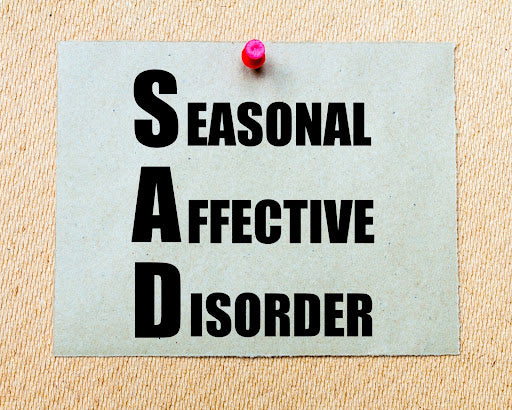If you’ve noticed a pattern of having depressive episodes during fall and winter months, which dissipate when spring arrives, it’s possible that you have seasonal affective disorder. Not to be confused with the “winter blues,” which is a much milder experience, seasonal affective disorder is a form of major depression that affects around five percent of adults in the U.S. and it typically lasts about 40 percent of the year.1 Explore the symptoms of seasonal affective disorder and treatment plans to consider.
What Is Seasonal Affective Disorder?
Often called “winter depression” or “seasonal depression,” seasonal affective disorder (SAD) is classified in the Diagnostic Manual of Mental Disorders (DSM-5), as Major Depressive Disorder with Seasonal Pattern.2
Typically, depression begins and ends during a specific season every year (with full remittance during other seasons), with individuals having more seasons of depression than seasons without depression over a lifetime. Seasonal pattern disorders occur most frequently in winter although, in rare cases, they can also occur in summer.3
Researchers have found that people with seasonal affective disorder have difficulty regulating serotonin, sometimes called the “happy hormone,” which is a neurotransmitter associated with regulating mood. In one 2014 study, individuals with SAD had five percent more SERT, a protein that assists with serotonin transport, in the winter months than in summer.4 This resulted in lower serotonin activity and depressive symptoms. Throughout the summer, sunlight seems to keep SERT levels naturally low, but as sunlight diminishes in the fall, a decrease in serotonin activity also occurs, proving a correlation between serotonin and the body’s circadian rhythms.5
There is also some evidence that people with SAD may have difficulty with an overproduction of melatonin, which is a hormone that responds to darkness by inducing sleepiness.6 During dark winter months, melatonin production increases, producing sleepiness and lethargy in individuals with SAD.
What Are the Symptoms of Seasonal Depression?
The symptoms of seasonal depression are related to symptoms of major depression. Though they vary by individual, the National Institute of Mental Health lists the following symptoms for SAD:7
- Feeling depressed nearly every day for a large majority of the day
- Loss of interest in activities you once enjoyed
- Changes in appetite or weight
- Sleep issues
- Feeling fatigued or agitated
- Loss of energy
- Feeling hopeless or worthless
- Lack of focus
- Suicidal ideation
They also list the following symptoms for winter-pattern SAD:
- Oversleeping
- Overeating and weight gain
- Social isolation
And these symptoms are associated with summer-pattern SAD:
- Insomnia
- Loss of appetite and weight loss
- Restlessness and agitation
- Anxiety
- Aggression or violence

Who Does It Affect?
Though millions of people are affected by SAD, it impacts more women than men due to what researchers say is a connection between serotonin and estrogen levels.8 It is also more common in northern regions where there are shorter daylight hours in the winter, such as Alaska or New England. There is some evidence that SAD may co-occur with other mental health conditions, such as major depressive disorder, bipolar disorder, anxiety disorders, and even ADHD.9
Medication Treatment Options
Some people with SAD are prescribed antidepressant medications to ease their symptoms, such as bupropion. The medication is typically started before symptoms begin, but doctors may recommend that you continue taking them even after the symptoms go away. It should be noted that many antidepressants come with a variety of side effects such as headache, weight loss, dry mouth, insomnia, nausea, dizziness, constipation, fast heartbeat, and sore throat.10 These drugs may also lead to dependence and withdrawal effects if you decide to come off the medication.
An alternative to prescription antidepressant medication is Brillia, a non-prescription homeopathic medication that uses targeted antibodies to the brain-specific S100B protein instead of synthetic chemicals. Studies show that feelings of anxiety, irritability, and inattention stem from an imbalance of the S100B protein, a key regulator of mood. Brillia works by seeking out and attaching to this protein and changing its shape, hindering its ability to instigate symptoms of anxiety and ADHD, which can be especially helpful for those with these co-occurring conditions. As a result of the regulating effect of Brillia on the protein S-100, the level of monoamines (dopamine, norepinephrine, and serotonin) in different parts of the brain normalizes.
Holistic Ways to Combat Seasonal Affective Disorder
Some other non-prescription routes to combating SAD include psychotherapy and light therapy, in which you expose yourself to bright light by sitting a few feet from a special light box within the first hour of waking up each day. Light therapy is meant to mimic natural outdoor light and cause a change in brain chemicals linked to mood.
Lifestyle changes can also make a difference in supporting a balanced mood. Try the following:
- Prioritize social activities during months you’re most affected, as social isolation tends to exacerbate feelings of depression
- Follow good sleep hygiene such as waking up at the same time every day and going to bed at the same time
- Exercise regularly
- Though it may be spare, try to spend as much time as you can in natural sunlight
- Take vitamin D supplements
- Eat a healthy diet of dark, leafy greens, fiber-rich foods, nuts, fermented foods, fatty fish, and dark chocolate11
- Practice mindfulness and relaxation techniques
If you decide to try Brillia, our holistic approach is supported by a variety of healthy lifestyle factors outlined in our 5-Pillar methodology. Find out more about how Brillia works and explore resources on how to support whole-body health in every season at the Brillia blog.
Get a whole bunch of support right in your inbox.





